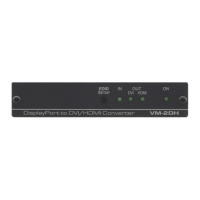3 Overview
The Kramer VM-2DH is a DisplayPort to DVI/HDMI converter and distributor for
digital signals that is HDCP (High-Bandwidth Digital Content Protection)
1
compatible. Since high-resolution DVI signals are very sensitive to cable quality
and to PCB layout, the VM-2DH uses a uniquely designed PCB which includes all
buffering, conditioning and amplifying circuitry to provide two high-level output
signals.
In particular, the VM-2DH features:
• Support for resolutions up to WUXGA, including all HDTV formats
• A bandwidth of 1.65Gbps
• The DDWG
2
DVI 1.0 standard
• Support for up to eight embedded audio channels
• Built in re-clocking circuitry that regenerates the DVI/HDMI signal so that
several units may be cascaded
• A non-volatile read and store memory for the EDID (Extended Display
Identification Data) block from one of the outputs, so it can then provide the
EDID information to the DisplayPort source even if the display device is not
connected
• A default EDID for fast and efficient connection of the unit
3
• I-EDIDPro™ Kramer Intelligent EDID Processing™—intelligent EDID
handling and processing algorithm that ensures Plug and Play operation for
DVI/HDMI systems
• A DVI-I connector which is compatible with all types of DVI cables
• State-of-the-art line drivers on both outputs to provide a cost-effective
solution for distributing the TMDS
4
signals used for DVI/HDMI
3.1 About HDCP
The High-Bandwidth Digital Content Protection (HDCP) standard
5
protects digital
video and audio signals transmitted over DVI or HDMI™ connections between
two HDCP-enabled devices to prevent the reproduction of copyrighted material.
To protect copyright holders (such as movie studios) from having their programs
copied and shared, the HDCP standard provides for the secure and encrypted
transmission of digital signals.
1 Note that Kramer Electronics Limited is an HDCP Licensee, see http://www.digital-cp.com/about_dcp/list
2 Digital Display Working Group (
http://www.ddwg.org)
3 The default EDID feature lets you connect the VM-2DH without having to connect a display to the output
4 Transition Minimized Differential Signaling
5 Developed by Intel

